Types Of Hibiscus Flower Species & Kinds
Hibiscus is a beautiful flowering plant that comes in a variety of types and colors. You can divide them into hardy, tropical, and perennial hibiscus.
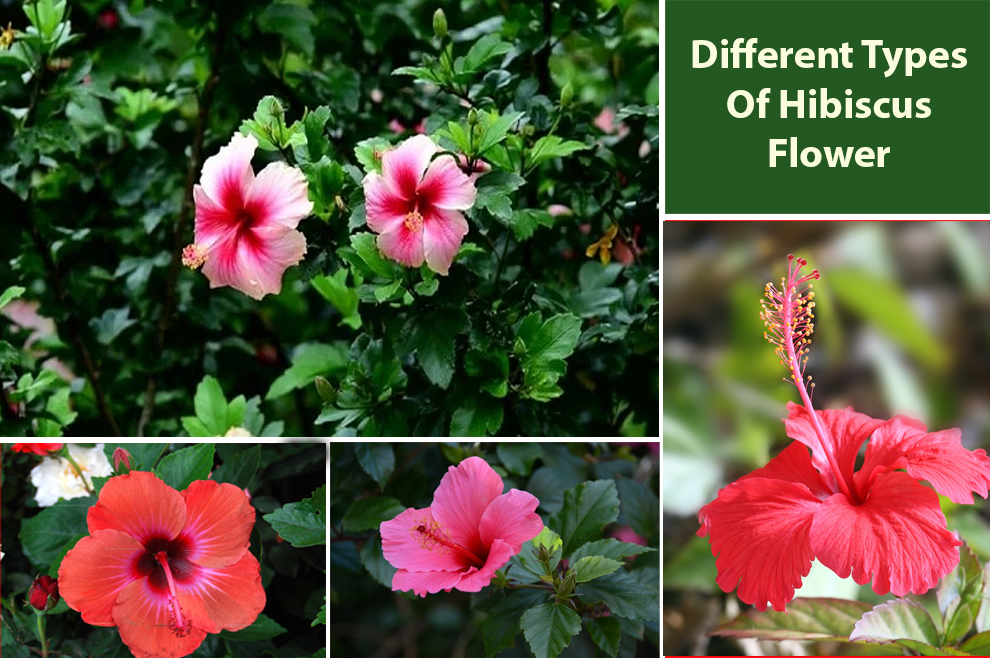
Hibiscus is a beautiful and diverse genus of flowering plants that includes hundreds of species and thousands of cultivars. There are many types of hibiscus flowers, each with its unique characteristics and growing requirements.
From hardy perennials to tropical shrubs, hibiscus plants come in a wide range of sizes, colors, and shapes.
Some of the most common hibiscus types include the hardy hibiscus, which is native to North America, and the tropical hibiscus, which is native to Asia and the Pacific Islands.
Other popular varieties include the Rose of Sharon and the Chinese hibiscus.
Whether grown in gardens, landscapes, or indoor spaces, hibiscus flowers are a popular choice for their stunning beauty and easy-to-grow nature.
Hibiscus Flower Information
| Plant Common Name | Hibiscus |
| Scientific Name | Hibiscus |
| Bloom time (month) | Hardy hibiscus varieties tend to bloom in August. Tropical hibiscus, on the other hand, can bloom throughout the year in warm climates. |
| How long does hibiscus bloom? | Hibiscus flowers last for a few days to a week. |
| Flower color | Different types of hibiscus flowers come in a wide range of colors, including red, pink, orange, yellow, white, and even blue. |
| Hibiscus Care |
|
Types of Hibiscus Flower Variety
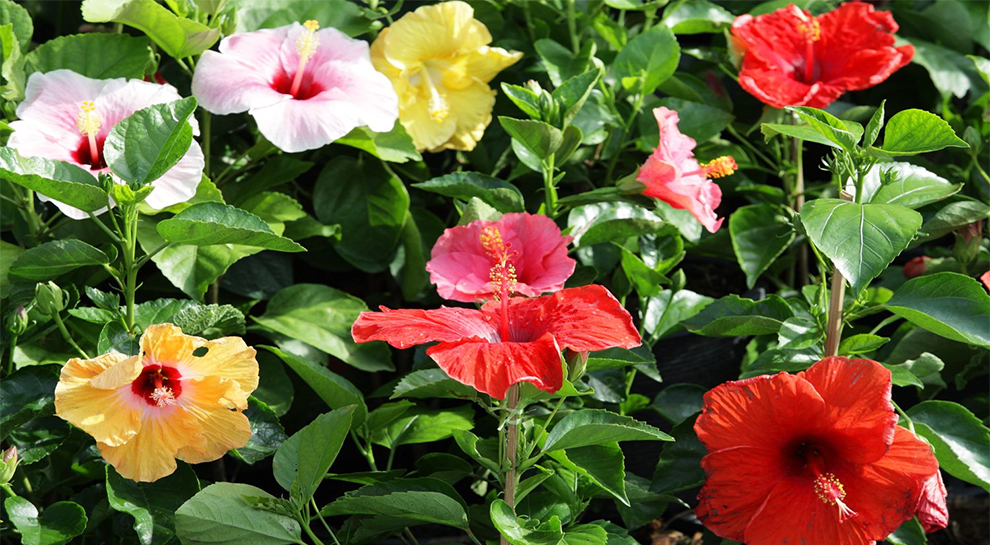
There are many hibiscus flower varieties, each with its unique bloom time, characteristics and attributes, including:
A. Perennial Hibiscus
Perennial hibiscus plants are those that live for multiple years, typically returning to grow and bloom year after year.
They are hardy plants that can withstand cold temperatures and come back in the spring, whereas annual hibiscus plants complete their life cycle within a single growing season and do not survive the winter.
Here are some examples of perennial flowers of hibiscus varieties:
1. Hibiscus moscheutos
Also known as the swamp rose mallow, this hibiscus flower variety is a hardy perennial that is native to North America.
It produces large, showy flowers in shades of pink, white, and red. Some varieties may also have bicolor or multicolor blooms.
The swamp rose mallow typically blooms from midsummer to early fall. It is a hardy plant that grows well in moist, swampy areas or along the edges of ponds and streams.
It can also be grown in gardens, flower beds, or containers, as long as it is provided with ample water and well-draining soil. This hibiscus variety can grow up to 6 feet tall and 4 feet wide, forming a large, bushy shrub with many stems.
2. Hibiscus coccineus
Also known as the scarlet hibiscus, this hibiscus variety is a hardy perennial that produces bright red, cup-shaped flowers.
The scarlet hibiscus blooms in mid to late summer, typically from July to September in its native range. The flowers are short-lived, usually lasting only a day or two, but the plant produces many buds to ensure a long blooming season.
Hibiscus coccineus thrives in moist to wet soils, such as marshes, swamps, and along stream banks. This hibiscus variety can grow up to 6-8 feet tall and 3-4 feet wide.
3. Hibiscus laevis
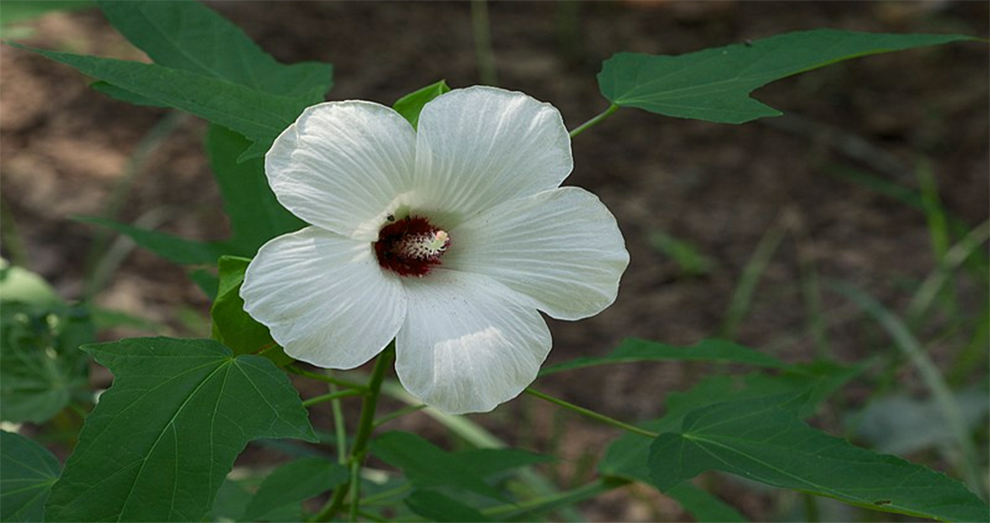
Also known as the halberdleaf rose mallow, these kinds of hibiscus flowers are hardy perennials that produce large, showy pink or white flowers.
The halberd-leaved rose mallow blooms in mid to late summer, typically from July to August in its native range.
Hibiscus laevis prefers moist to wet soils and is commonly found in wetlands, marshes, and along stream banks. It can also be grown in gardens or flower beds with ample water and well-draining soil.
4. Hibiscus acetosella
Also known as the African rose mallow, this hibiscus variety is a perennial shrub that produces striking, deep red flowers that are popular for their ornamental value.
Hibiscus acetosella is typically grown in warm, humid climates and can be found in tropical regions of Africa, the Caribbean, and South America.
It can also be grown as a potted plant in colder climates and brought indoors during winter. It prefers well-drained soil and full sun to partial shade.
There are several other perennial hibiscus flower species that you may encounter:
- Hibiscus syriacus
- Hibiscus mutabilis
- Hibiscus sabdariffa
- Hibiscus heterophyllus
B. Tropical Hibiscus
Tropical hibiscus is a flowering plant that is native to warm, tropical regions around the world. It is a popular ornamental plant that is often grown in gardens and as houseplants.
It is also used for medicinal purposes in some cultures, with flowers and leaves being used to treat various ailments such as fever, coughs, and skin irritations.
Some of the most popular tropical types of hibiscus flower include:
1. Hibiscus rosa-sinensis ‘Double Peach’
Double Peach or Double Peach Hibiscus is a variety of tropical hibiscus (Hibiscus rosa-sinensis) that is known for its double-layered, peach-colored blooms. They typically bloom in the summer months but can continue to produce flowers year-round in warm, tropical climates.
It is native to parts of Asia but is now grown as an ornamental plant in many warm regions around the world. It grows best in full sun to partial shade, and in well-drained soil.
2. Hibiscus rosa-sinensis ‘Orange Crush’
The common name for Hibiscus rosa-sinensis ‘Orange Crush’ is Orange Crush hibiscus. As the name suggests, the flower color is orange, and it has a large, single blossom with a prominent yellow stamen.
Orange Crush hibiscus blooms in the summer and fall months, typically from late June to early October, depending on the climate and location. It is a tropical plant and can grow in USDA hardiness zones 9-11. It requires full sun to partial shade and well-draining soil to thrive.
3. Hibiscus rosa-sinensis ‘White Wings’
Hibiscus rosa-sinensis ‘White Wings’, also known as White Wings hibiscus, white flower with a large, single blossom that has a prominent yellow stamen.
The flowering time of ‘White Wings’ hibiscus can vary depending on the climate and growing conditions, but it typically blooms in the summer months, from late June through August.
In some warmer regions, it may begin blooming earlier in the spring and continue blooming through the fall. It grows well in full sun to partial shade and requires well-draining soil to thrive.
4. Hibiscus rosa-sinensis ‘Queen of Hearts’
Hibiscus rosa-sinensis ‘Queen of Hearts’ is a cultivar of the Hibiscus rosa-sinensis plant that is commonly known as Queen of Hearts hibiscus. The flower color of this hibiscus flower species is a deep red shade.
The blooming time of ‘Queen of Hearts’ hibiscus is in the summer months, from June through August. This tropical plant can grow in USDA hardiness zones 9-11 and requires well-draining soil and full sun to partial shade for optimal growth.
5. Hibiscus rosa-sinensis ‘Yellow Queen’
Hibiscus rosa-sinensis ‘Yellow Queen’ also known as ‘Yellow Queen’ is a specific variety of tropical hibiscus that has large, bright yellow flowers.
In addition to its vibrant flowers, ‘Yellow Queen’ is also appreciated for its glossy green leaves, which provide a nice contrast to the bright blooms. It is a popular cultivar among gardeners and is often grown as a decorative shrub or potted plant.
‘Yellow Queen’ is a tropical plant that is typically grown in warm, humid regions including parts of Africa, Asia, Australia, and the Americas.
The best time to plant ‘Yellow Queen’ is in the spring or early summer, after the danger of frost has passed and when temperatures consistently reach at least 60°F (15°C).
6. Hibiscus rosa-sinensis ‘Coconut Queen’
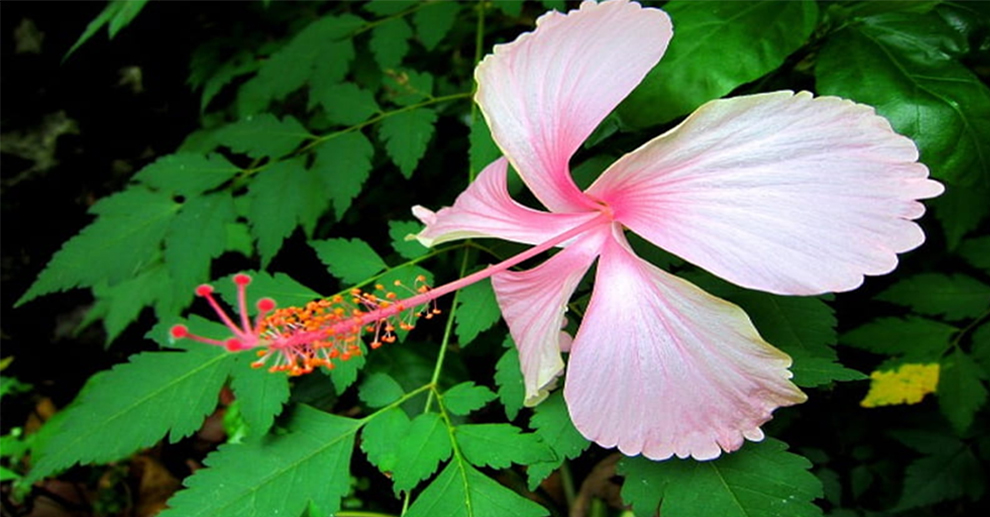
Hibiscus rosa-sinensis ‘Coconut Queen’ is another cultivar of the tropical hibiscus that is known for its distinctive appearance.
Commonly known as ‘Coconut Queen’, it is named for its unique flower, which has a creamy white center and bright pink outer petals, giving it a “coconut” or “candy cane” appearance.
The ‘Coconut Queen’ thrives in warm and humid regions. The leaves of the ‘Coconut Queen’ are deep, glossy green, and have a slightly serrated edge. ‘Coconut Queen’ prefers warm temperatures and plenty of sunlight.
Some other tropical varieties include:
- Hibiscus rosa-sinensis ‘Flamingo’
- Hibiscus rosa-sinensis ‘Moy Grande’
- Hibiscus rosa-sinensis ‘President’
- Hibiscus rosa-sinensis ‘African Queen’
- Hibiscus rosa-sinensis ‘Yellow Submarine’
- Hibiscus rosa-sinensis ‘Jupiter’
- Hibiscus rosa-sinensis ‘Peach Blow’
C. Hardy Hibiscus
Hardy hibiscus is a type of hibiscus that is native to North America. It is a hardy perennial plant that can tolerate colder temperatures than tropical hibiscus varieties and can be grown in USDA Hardiness Zones 4-9.
1. Hibiscus moscheutos ‘Luna Pink Swirl’
Hibiscus moscheutos ‘Luna Pink Swirl’ is a type of hardy hibiscus flower species that is native to the southeastern United States. It is a perennial that produces large, showy flowers in shades of pink and white, with a distinctive swirl pattern on the petals.
The ‘Luna Pink Swirl’ variety is known for its compact size, reaching only 2-3 feet in height, making it a great choice for small gardens or container planting.
This hibiscus plant prefers full sun and moist, well-drained soil. The plant blooms from midsummer through early fall, attracting bees, butterflies, and hummingbirds with its nectar-rich flowers.
2. Hibiscus syriacus ‘Rose of Sharon’
Hibiscus syriacus, commonly known as the Rose of Sharon, is a deciduous shrub that is native to China and India but is widely cultivated throughout the world.
‘Rose of Sharon’ is a cultivar of this species, prized for its beautiful flowers that range in color from white to pink, purple, and blue. It typically blooms in mid to late summer and continues to flower until the first frost.
The plant can grow up to a height of 10 feet and 6 feet wide and prefers full sun to partial shade. It is tolerant of a wide range of soil types but prefers well-draining soil. The plant is also drought-tolerant once established and is relatively low-maintenance.
3. Hibiscus moscheutos ‘Lord Baltimore’
Hibiscus moscheutos ‘Lord Baltimore’ is a cultivar of the hardy hibiscus plant species that are native to the southeastern United States.
It is a deciduous perennial that produces eye catchy flowers in shades of deep red, with a dark red eye and prominent stamens. The flowers can be up to 12 inches in diameter and bloom from mid-summer through early fall.
The plant can grow up to 6 feet tall and 4 feet wide in full sunlight and partial shade. It prefers moist, well-draining soil and is relatively low-maintenance, although it may require occasional pruning to remove dead or damaged growth.
4. Rose mallow (Hibiscus moscheutos)
Rose mallow (Hibiscus moscheutos) is a hardy hibiscus flower variety that is native to the eastern United States. The plant produces large, showy flowers that can be up to 12 inches in diameter, with five petals that range in color from white to pink, red, and purple.
The flowers bloom from mid-summer through early fall and attract a variety of pollinators. The leaves are large and green, with a heart-shaped or palmate shape.
Rose mallow is relatively easy to grow and prefers full sun to partial shade. Although it prefers moist and well-drained soil, it is tolerant of a wide range of soil types.
5. Hibiscus moscheutos ‘Kopper King’
Hibiscus moscheutos ‘Kopper King’ is a hardy hibiscus plant species that are native to the southeastern United States. It is a deciduous perennial that produces large, showy flowers in shades of pink with a distinctive coppery-red center. The flowers can be up to 12 inches in diameter and bloom from mid-summer through early fall.
The plant can grow up to 5 feet tall and 4 feet wide and prefers full sun to partial shade. One of the unique features of ‘Kopper King’ is its foliage. The leaves are deep green with a bronze or copper-colored tint, adding an extra dimension of interest to the plant.
6. Hibiscus moscheutos ‘Robert Fleming’
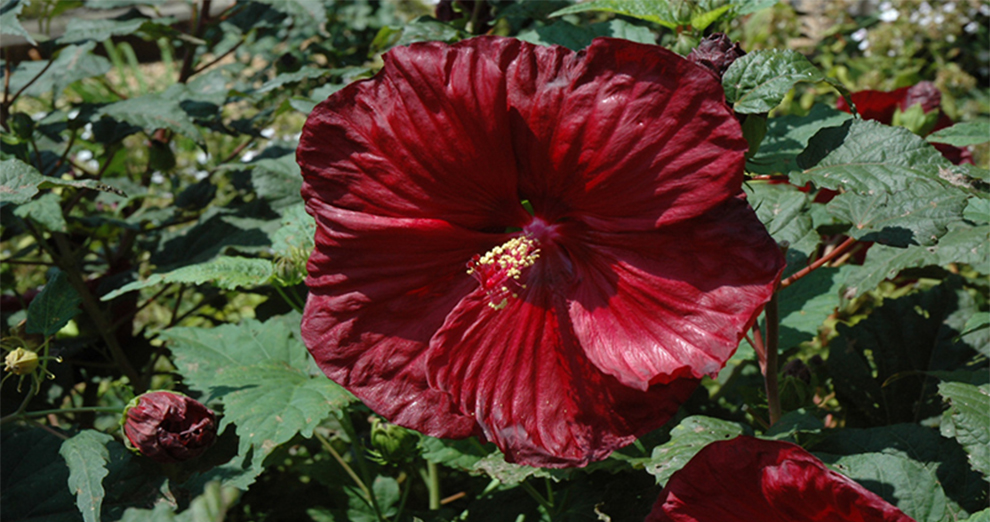
‘Robert Fleming’ is named after a horticulturist and plantsman who played a key role in the development of the hardy hibiscus as a garden plant. Among all the kinds of hibiscus flowers, this cultivar is noted for its large, vibrant flowers and its ability to thrive in a range of growing conditions.
It is a deciduous perennial that is native to the southeastern United States and produces large, showy flowers in shades of deep pink with a dark red eye.
The flowers can be up to 10 inches in diameter and bloom from mid-summer through early fall. Full sunlight to partial shade and moist, well-draining soil is ideal for this plant.
7. Hibiscus moscheutos ‘Blue River II’
‘Blue River II’ is a hybrid cultivar that was developed specifically for its beautiful large, showy flowers in shades of white color.
The flowers grow up to 10 inches in diameter and bloom from mid-summer through early fall. The plant is native to the southeastern United States.
It blooms in mid-summer through early fall. The plant can grow up to 5 feet tall and 3 feet wide and prefers full sun to partial shade. It is comparatively low maintenance with only occasional pruning required.
Some other hardy hibiscus varieties include:
- Hibiscus moscheutos ‘Disco Belle’
- Hibiscus syriacus ‘Aphrodite’
- Hibiscus syriacus ‘Minerva’
- Hibiscus syriacus ‘Blue Satin’
- Hibiscus mutabilis
Related: Types of Cosmos Flowers|How To Grow Hibiscus|How to Care for Hibiscus Plants Indoors
Different Types Of Hibiscus Flowers Based On Color
Hibiscus flowers come in a wide range of colors, including shades of white, yellow, orange, pink, red, purple, and blue. Here are some hibiscus types categorized based on their color:
A. Red hibiscus varieties
Flamenco, President, Red Dragon, Double Red, Red Heart, Lord Baltimore, and Red Shield.
B. Yellow hibiscus varieties
Lemon drop, Ardens, Yellow Submarine, Lutea, Luna Yellow, Hibiscus schizopetalus, and Hibiscus calyphyllus.
C. Pink hibiscus species
Pink Giant, Hibiscus mutabilis, Pink clouds, Pink Double Delight, Pink Parfait, and Minerva.
Which Are The Common Dwarf Hibiscus Varieties?
Some of the common varieties of dwarf hibiscus include:
- Fiesta Hibiscus
- Carnival Hibiscus
- Miniature Hibiscus
- Tiny Tuff Stuff Hibiscus
- Lil’ Kim Hibiscus
- Red Rover Hibiscus
Which Are The Huge Flowers That Look Like Hibiscus?
There are a few kinds of flowers that are often mistaken for hibiscus due to their similar appearance. Here are some examples of flowers that may be confused with hibiscus:
1) Peonies
2) Canna Lilly
3) Bush Mallow
What Is The Most Beautiful Hibiscus Flower?
Some popular hibiscus varieties known for their beauty and ornamental value include the Chinese hibiscus (Hibiscus rosa-sinensis), the tropical hibiscus (Hibiscus rosa-sinensis), and the hardy hibiscus (Hibiscus moscheutos).
Which Hibiscus Is The Most Fragrant?
While hibiscus plants are known for their vibrant and showy flowers, not all varieties produce a strong fragrance.
However, there are a few hibiscus flower variety that is known for their pleasant scent including Hibiscus rosa-sinensis ‘Cooperi’, Hibiscus syriacus ‘Diana’, Hibiscus moscheutos ‘Lord Baltimore’, Hibiscus schizopetalus.
It’s important to note that fragrance can vary depending on growing conditions, and some individuals may have a more sensitive sense of smell than others.
